#taungs
Text
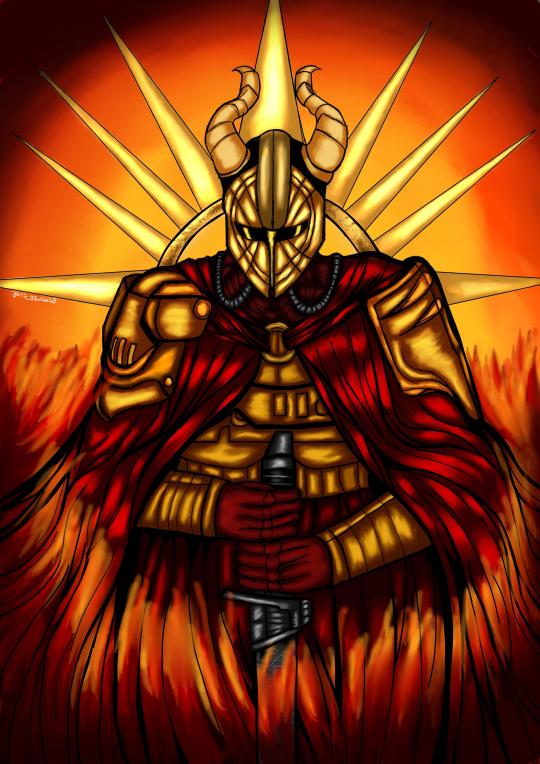
FINALLY
DONE
#crackedopen art#my art#my redesigns#crackedopen ocs#crackedopen worldbuilding#beginner digital artist#mandalorian culture#mand'alor#mandalorians#mandalore#mandalore the ultimate#my taung redesign#taungs#the old republic#star wars#star wars fanart#digital artwork#digital drawing#digital art#sketchbook#darksaber
20 notes
·
View notes
Text
Cienie’s take on Mandalorian Culture: Kad Ha’rangir and mandalorian traditional weapons, p.2
part 1
There are in theory contradicting sources about Taungs - namely Death Watch Manifesto [Bounty Hunter Code], Star Wars: The Essential Guide to Warfare Author’s Cut, Part 2 – Ancient Coruscant and Republic Collapse, all written within the TCW era (2008-2020) and Mandalorian song Vode An best known from the Republic Commando game soundtrack (2005).
The first source claims that Taung Crusaders “relied primarily on handheld weapons such as beskade and Mythosaur axes” and that those weapon forms inspire modern Mandalorian designs.

Bounty Hunter Code also included an artistic version of Taungs proving themselves against Mythosaur, while using swords / sabers against the beast.
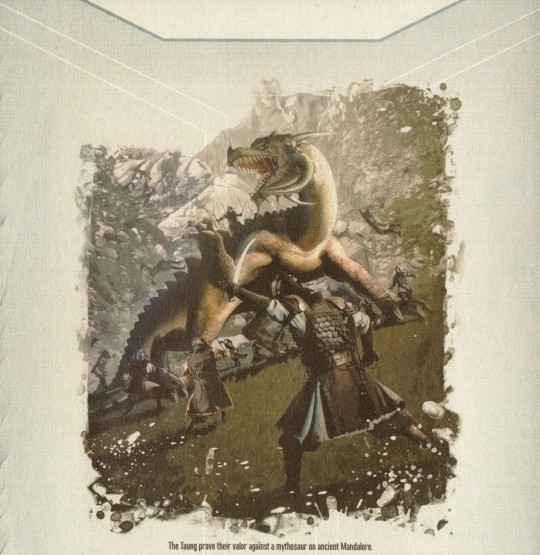
The problem with the Death Watch Manifesto lies in its political nature and so can’t be treated as an objective source. The point of Manifesto was to gain new loyal members of Death Watch (the loyalists of Old Faith) to fight against Duchess Satine Kryze’s pacifist rule. Text provided simplified version of the conflict between warriors and so called Faithless supported by Republic and Jedi from supposedly perspective of Tor Vizsla[3], including emphasis on repression that happened upon the traditionalists, such like exile to Concordia and intentional destruction of their culture:
“Seven centuries ago, their craven, hut’uune warships and Jedi bombarded our worlds. They incinerated Mandalore’s farmland and forests, leaving much of our homeworld a forsaken desert of fine white sand, and then occupied our worlds. They killed, exiled, or disarmed our warriors and suppressed our ancient codes.
or
“Our secret operations on Mandalore and Concordia are producing more and more beskar, but Mandalorian armor remains hard to find - and the New Mandalorians treacherously destroyed many heirloom suits of beskar’gam.”
and
“Some of our warriors were exiled to the moon Concordia. Others - myself included - slipped away to resume the ba’slan shev’la”.
This raises a question: how close to the truth is the knowledge provided by the author? If warrior culture were systematically erased for ages within Mandalorian society, then there is a high possibility that author’s knowledge is either
incomplete - the ancient tradition was passed in secret for ~700 years and from the start was designed to uphold customs that warriors should consider sacred, thus the only one correct and right version to believe. After such a long time Tor Vizsla (and Death Watch members in general) may simply repeat already whitewashed “history lessons” that for ages fitted Faithfuls’ needs. In that case we could assume the author himself does not lie on purpose and simply presents the knowledge passed through generations between traditional Mandalorians.
deliberately present information in a way that fits the Death Watch’s rhetoric to manipulate/encourage readers to the author's case. This doesn’t mean Tor is lying about events per se, as Sith War, Mandalorian Wars and Republic attack on Mandalore did happen and have confirmation in different sources, however the manner of presenting is clearly non-objective. This is especially noticeable in a way Mandalorians are separated into Faithful working hard to keep their culture alive and thus in symbolic way face and overcome the trials of Kad Ha’rangir (the warrior / positive god) while Pacifist choose the easier way and follow the Arasuum (negative god) or how the text focus so much on connecting modern Mandalorians to their mythical-historical progenitors as Mandalore the Ultimate (who opened Mandalorian warrior ranks to anyone worth of the title) and Taungs in general.
Of course, those two options don’t exclude each other and may easily co-exist, as the author operates on knowledge passed down to him while presenting it in a favorable way to potential members of Death Watch. Which leads me back to Taungs using swords and what traditional weapons means.
Taungs at some point needed to pass down their metallurgist knowledge to humans and other assimilated Aliens so it is very possible that their blacksmiths in fact had made those types of weapon, especially in a period of time close to Mandalorian Wars. The new warriors (Neo-Crusaders) needed to be properly equipped - and many “recruits”came from Republic territories thus could be more familiar with sword fighting than using axes, so the author may not be wrong about ancient Mandalorian design on which the modern beskar swords are based to some degree. With Mandalorian culture existing for over 7000 years, both (Taung) axes and (Mandalorian human) swords at some point became seen as traditional Mandalorian weapons however there is no way to say for sure did Tor Vizsla had a proper knowledge about Taung battle methods or did he stretched the facts for propaganda, as another cultural tradition that humans shared with the ancient Mandalorians?
Considering the nature of the Death Watch Manifesto and mentioned destruction of warrior culture by New Mandalorians (Republic), I tend to favor the latter possibility. Especially when the three most important ancient Mandalorian (Taung) deities presented in the same Manifesto carry no sword-like weapon. Which again raises a question, what is the point of a god called Kad (sword) if the available picture (interpretation) shows him with a Taung-like traditional ax?
Hod Ha’ran too carries an axe while only Arasuum either is using ceremonial(?) cane or his weapon is deliberately held blade down, as a sort of symbol of giving up warrior nature (that author of Manifesto clearly ties to “traitorous” pacifism).
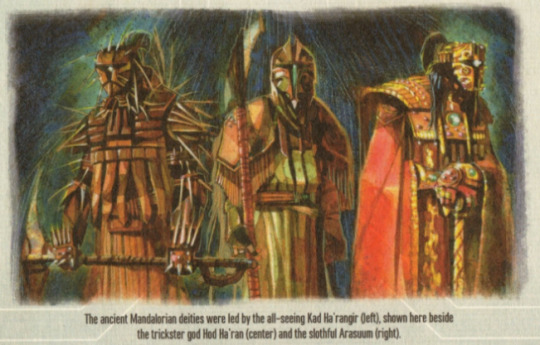
The ancient Mandalorian deities were led by the all-seeing Kad Ha’rangir (left), shown here beside the trickster god Hod Ha’ran (center) and the slothful Arasuum (right).
This is even more palpable, as:
🔶Mandalore the Indomitable was presented with a typical mythosaur axe and spear - weapons both used by the Taung leader in original comics.
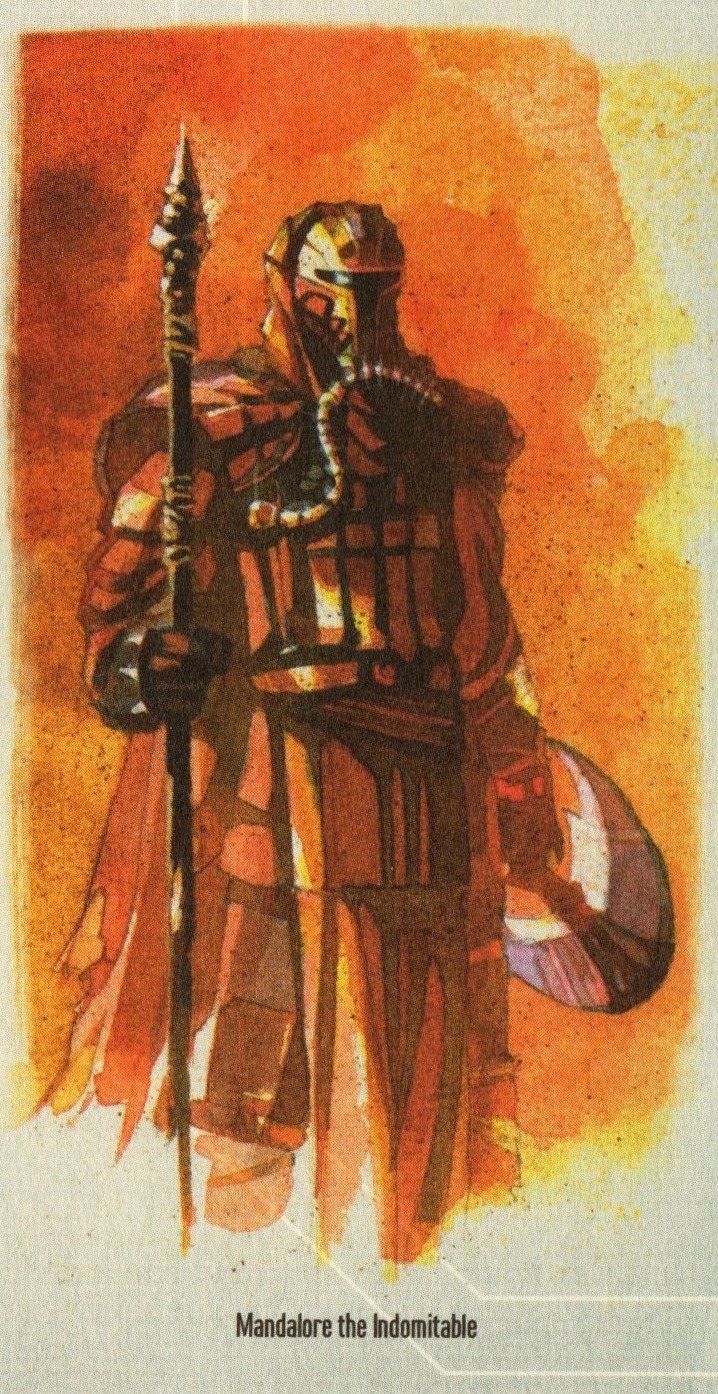
Comparing his image to other important figures from Mandalorian history, this Taung is the only one that holds a traditional weaponry while the Ultimate (and some unnamed characters) has a blaster and the rest don’t hold any armament at all. Interestingly, Tor is pictured twice - first, with a sort of technologically advanced spear/lance(?) and secondly with a darksaber.
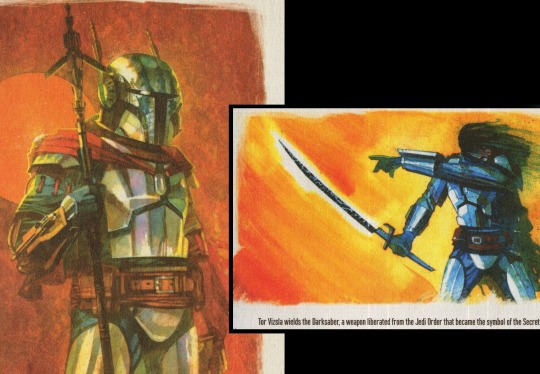
The lack of blaster connects him the strongest with Indomitable yet not with the gods who use solely axes.
🔶the sabers used by Taungs, as far as can be seen on the Mythosaur picture, don’t resemble the presented above sword design (it does however fit the author’s description “a single-edged, curved sword”). One may argue that those two types represent different eras, which is a fair argument - with a culture reaching 7 thousands years there is no reason to think the armament didn’t evolve according to the needs of warriors who took part in endless war campaigns. However, from a propaganda purpose solely, I find it interesting how the author didn’t try to connect each bit of lore of original Mandalorians to swords and in result, highlight the importance of the Darksaber. Instead we are told that Taungs used both swords and axes and the book even presented a bunch of unnamed warriors with sabers, yet the Indomitable and Mandalorian gods are tightly tied to axes first and foremost. It could be really easy to present both of those figures with mentioned single-edged, curved swords that Darksaber resembles to some degree and keep it as a continuation of a great, old tradition. Yet the best known Taung mythological-historical characters do not use swords at all.
Another source, Star Wars: The Essential Guide to Warfare Author’s Cut, Part 2 – Ancient Coruscant was published on starwar.com in 2013 (and still can be read there). This in-universe text gives us some insight about historical education and archaeological works in regard to Taungs and prehistoric Battle of Coruscant:
Nor, says Hu, can we say anything about the Battalions of Zhell, or the Taung legions that confronted them.
“When enthusiasts stage recreations of the battle they tend to use replica great axes and swords known from the excavation of Taung burial sites on Roon,” he says. “But by the time the Taungs reached Roon these were ritual objects -- species capable of traveling through hyperspace don’t still rely on edged weapons. Nor do you find such weapons still used by societies as sophisticated as the Zhell nations. It’s as if you staged a recreation of the Siege of Ramsir with the Imperial Army limited to parade sabers.”
Hu says he knows it may be unromantic to imagine the confrontation at Zhell occurring between armies that possessed aircraft and atomic weapons. But he urges us to look deeper and examine the qualities of Dha Werda Verda that have kept the poem alive for eons.
(For those unfamiliar with the history of prehistoric Coruscant - Zhell nations were the ancient enemy against whom the forefathers of original Mandalorians fought for control over the planet. Ultimately, Taungs were driven away from the Coruscant and it is generally assumed that Zhells were humans.)
It is understandable that in-universe researchers won’t have the same knowledge as star wars fans familiar with Tales of the Jedi: The Sith War or Knights of the Old Republic various media - and in result in-universe assumptions may differ from “truth” (lore). Here are some vital details to take into account:
🟢For one, Taungs (ancient Mandalorians) were capable of traveling through hyperspace yet still used edged weapons during fight, as was proved in The Sith Wars. So the assumption axes or swords were solely ritual objects before Taungs even got to Roon doesn’t hold true. The traditional axes and swords may have some ritual importance (and thousands years later Din Djarin, a modern Mandalorian will claim, “weapons are part of my religion”) but their primary function is still fulfilled on the battlefield.
🟢The second detail worth examining is that axes and swords are mentioned solely in the context of graves. Source does not provide any additional information about the nature of those old burial sites and so there is no way to tell whether Taung cremated their dead (a continuation of prehistoric Taung funeral rites known from Dha Werda Verda poem?) or preferred skeleton burials. We don’t have any clue where the weapons were placed in the graves, if swords and axes were next to each other and if not, which kind of weapon were more often found in the closest immediate vicinity of the remains. There is also no information on what kind of advanced research was conducted on the blades to test if those were indeed battle weapons or items forged solely to fulfill the cultural/religious purpose. Due to lack of additional data, we can’t exclude a possibility that in one grave several weapons could be deposited and only one or two truly belonged and were used by the dead while the rest was simply grave goods - like the trophies taken from defeated enemies, a parting gift from the Taung community or, in case Roon was inhabited by other species (conquered and dominated or living peaceful alongside warriors?), a grave good related to a different social group and/or culture. Additionally, a specific funeral rites like cremation may not leave enough organic remains for a proper science research. If Taungs co-existed with other species, the graves with swords could belong to non-Taungs, either as a sign of honor /good relationship between separated cultures or as sacrificial burials on the occasion of Taung's funeral (as sacrifice of a slave/conquered people). Of course, those are just possibilities worth taking into account though sadly, we do not know the extent of in-universe archaeological research in that regard.
With such a large period of time Taungs spent on Roon, there is a great potential to create a proper correlation between type of weapon (its shape) and the chronology of burials and to theorize which weapon and when were the most popular. Similarly, there should be research done about correlation between type of weapon and alleged age, status and battle injuries of dead. As in, a certain type of weapon may be more often found in graves of esteemed adults (warriors) while the juvenile ones equipped appropriate to their age or lack of fighting experience.
Of course, Roon burial sites are older than 7.000 years and so archaeological excavations won’t solve all Taung cultural riddles and will depend a lot on the type of burial and its state of preservation but the point is, fiding swords in Taung graves does not automatically means it was their traditional weapon.
Thinking more about the issue, I’m intrigued by no mention of spears - and sure, organic parts such as wooden spar wouldn’t survive to modern times without proper conditions yet the stone or metal spearhead could. Especially since there are more examples of Taung using spear and spear-like weapons than swords.
The Essential Guide to Warfare gives an illustration of Taungs on prehistoric Coruscant (Notron) and if we take it at face value, spears are presented as a common weapon.

In the same sourcebook, The Indomitable was presented as holding glaive(?), while The Sith War also featured spear-like weapons used by Taung!Mandalorians alongside mythosaur axes, including Mandalore himself.
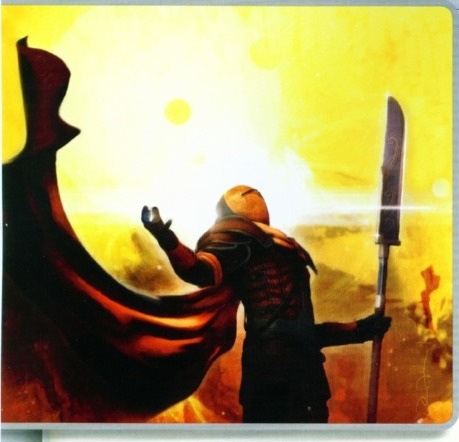
In The Essential Guide to Warfare even the Ultimate was presented with a spear - and doesn’t this picture resemble the prehistoric Taung leader?

Of course, over time Taung & early Mandalorians’ weapon preferences could change, yet the spears and axes are present in both a prehistoric and ancient period of their culture, while swords themselves either fell out of favor or have never been that common to begin with.
🟢 The third matter is that Taungs in times of living on Roon weren’t Mandalorians yet. Galaxy at War sourcebook states that they “battled the native Human nations for control of Coruscant before being driven off and forced to flee to the Outer Rim world of Roon, where they remain for millennia until the legendary Mandalore the First leads them to conquer another world.”
Of course, Taung primary culture is what Mandalorians were based on, yet millennia is a long span of time and so naturally cultural changes happened within their society. There is no clue if Kad Ha’rangir even predates the Mandalorian era or if his cult evolved once Mandalorians for good started their holy crusaders and destruction brought to many species. On one hand, if Kad Ha’rangir was a part of mythology existing during the Roon era, then we could argue that using swords could become a sort of religious taboo once Mandalorian culture came to life. Thus Taungs relied on mythosaur axes (probably based on the great axes mentioned in Author’s cut), spears and similar weapons while swords were sacred and maybe played a special religious function. However, if that was true, then why would Taung!Mandalorians accept human warriors / vassals to carry a sacred weapon?
Ancient Mandalorian society is implied to have more rigid structures than modern one, with a clear division into warriors and non-warriors social classes. If non-Taung part of society and newcomers could join Crusaders ranks before the Sith War then they should follow the same religious and/or cultural practices. Which could explain the general lack of traditional swords between Mandalore the Indomitable’s soldiers seen in the comics regardless of their biological species. At the same time Star Wars Miniatures included in Bounty Hunters set presented Mandalorian Blademaster - the set is not limited to one era but considering that
A) Mandalorian miniatures don’t have Neo-Crusader typical armors - if anything the shape and gray-black colors resemble Ordo Canderous’ armor[4] who according to KotOR Campaign Guide was already a warrior before Neo-Crusaders dominated Mandalorian culture
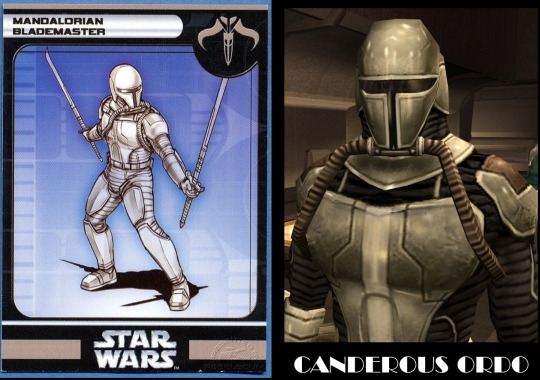
B) includes Mandalore the Indomitable and basilisk war droid rode by a warrior with again, no Neo-Crusader armor
C) various additional quotes and description on cards
may as well imply the Sith War and/or pre-Neo Crusaders culture.
Of course, there is no way to tell for sure if said Mandalorian Blademaster was meant to represent Taung or human/non-Taung species yet the existence of warriors specialized in swordfighting may suggest using swords was not a matter of religious taboo in the original warrior culture. At least not during the twilight period of their religion, as in the Indomitable’s times Taungs were said to worship the war itself, not gods in their primal version.
If we go further into the Great Adoption era, swords become more and more visible between warriors, as was presented:
on already mentioned illustration from The Essential Guide to Warfare

and here it is important to note that swords are held by Neo-Crusader(s) and Mandallian Giants. The latter were one of the first alien species included into Taung!Mandalorian ranks, before humans and Great Adoption.
Star Wars Miniatures also introduces Neo-Crusaders using swords such as
Mandalorian Marauder - KotOR set - with description “For years the Mandalorians were content to raid worlds on the Outer Rim, but during the Mandalorian Wars they began launching assaults across the Old Republic” suggesting the era of Great Adoption (opening ranks to non-Taungs)
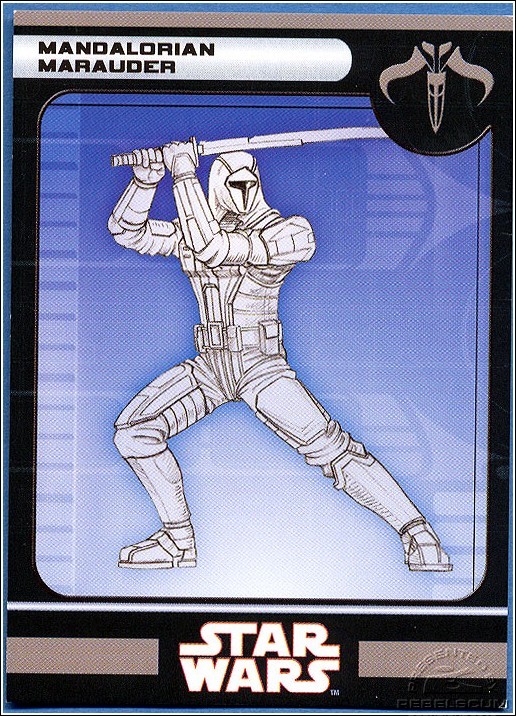
Mandalorian Jedi Hunter - Dark Times set - with description “Some of the scattered survivors of the Mandalorian Wars seek out Jedi to punish for their humiliation”. This model (quote) is clearly representing the post-Mandalorian Wars era in which Taungs are believed to be extinct.

yet still didn’t dominate the ratio of melee weapons. So we have previously mentioned KotOR Campaign Guide with majority of characters described as humans and whose stats of traditional weapons varied from unarmed, dragger, knife, mace, vibroblade, vibrodagger or bayonet while mythosaur axes are solely mentioned in regard to two Taungs, Mandalore the Indomitable and Ultimate.
From the above set, Canderous Ordo (future Mandalore the Preserver) has a dragger gauntlet, while the KotOR II Prima Guide advises to equip Ordo with swords.
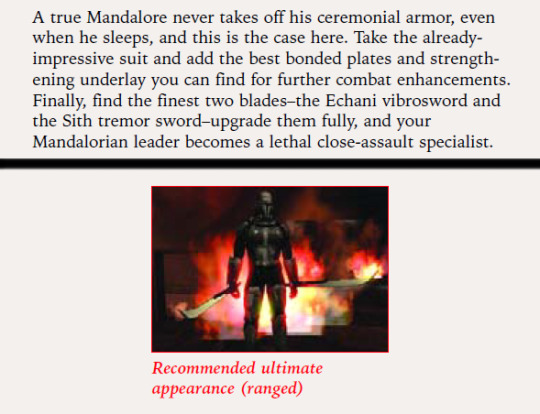
However in modern times, human Mandalorians are more commonly tied to swords (and knives or vibroblades in general) than axes, as can be seen in various sources:
A Practical Man
"And my name's Briika," said her hard-eyed mother. Her name came from the word for "smile," and Beviin enjoyed that kind of irony. She could shrivel anyone with that stare. "Those crushgaunts are illegal. But you know that."
"I just like antiques," Beviin said. He patted the scabbard on his belt, rattling an ancient saber in its sheath. "I've got a proper beskad, too. On the road for a reason?"
and
It could have ripped Beviin open like a canister. But his armor was forged from beskar, real Mandalorian iron that even Yuuzhan Vong weapons might not penetrate. He reached into his belt and drew his ancient beskad, a short razor-edged saber forged from the same.
Republic Commando: Triple Zero
"I opted to take on Vau. He had a real Mando iron saber, and I was unarmed.”
Collapse of the Republic sourcebook
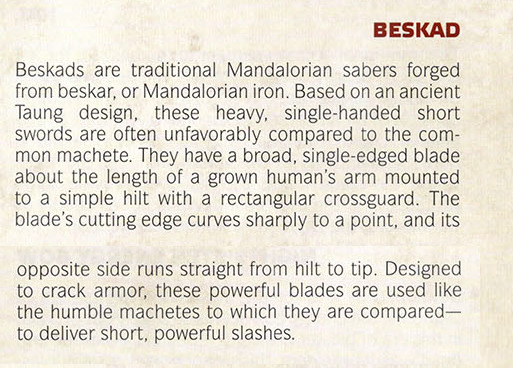
Jango Fett: Open Seasons
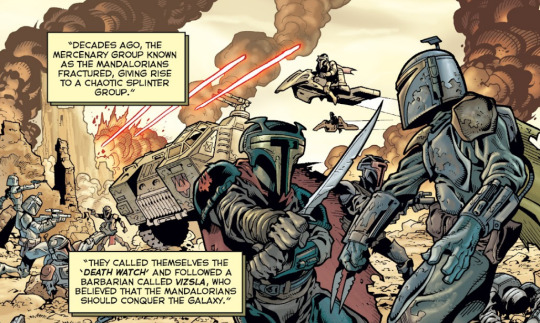
Star Wars Miniatures

Mandalorian Quartermaster whose design clearly was inspired by Death Watchman from Jango Fett: Open Seasons.
Star Wars – Clan Wren Unit Expansion
Card: Beskad Duelist (x)
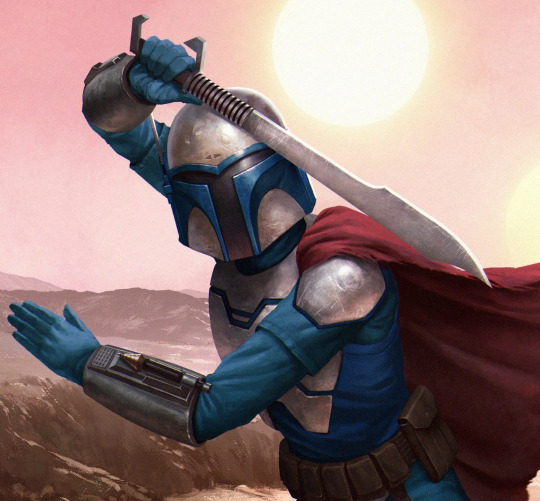
The Clone Wars
introduced Darksaber
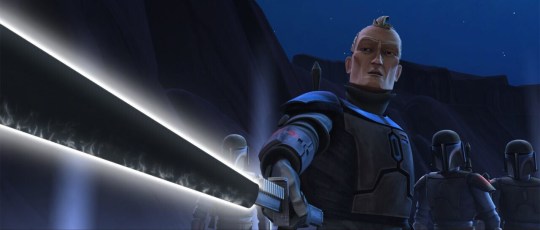
and the characteristic art seen in Pre Vizsla (and later in Duchess Satine)’s residence

and the mural decorating the city:
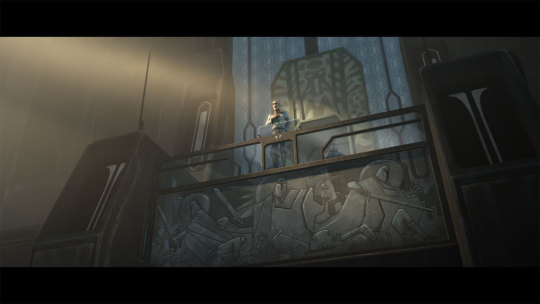
All presented there ancient(?) Mandalorian warriors carry a simple, two-edge(?) swords.
Sidenote: Darksaber originally was introduced as heirloom passed down in clan Vizsla, not the item representing the right to title of Mandalore. However since the later lore presented Tarre Vizsla, the first and for now the only New Canon Mandalorian Jedi, there is a question - should TCW!art be seen as a cultural shift from Taung weapons to human swords inspired by the figure of Tarre and his legendary darksaber?
Star Wars Rebels
presents Darksaber as ancient and culturally important weapon:
"I didn't know Mandalorians developed a type of lightsaber."
"We didn't. This was one of a kind. Legend tells that it was created over a thousand years ago by Tarre Vizsla, the first Mandalorian ever inducted into the Jedi Order. After his passing, the Jedi kept the saber in their temple. That was until members of House Vizsla snuck in and liberated it. They used the saber to unify the people and strike down those who would oppose them. One time, they ruled all of Mandalore wielding this blade."
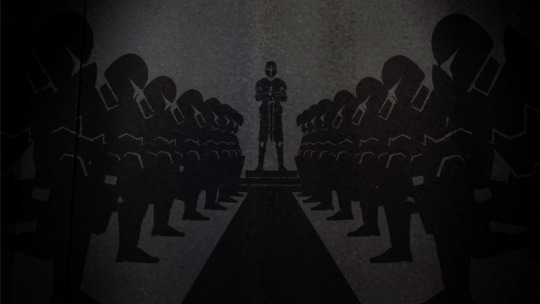
Forces of Destiny: Art History
(the short animation can be seen here)

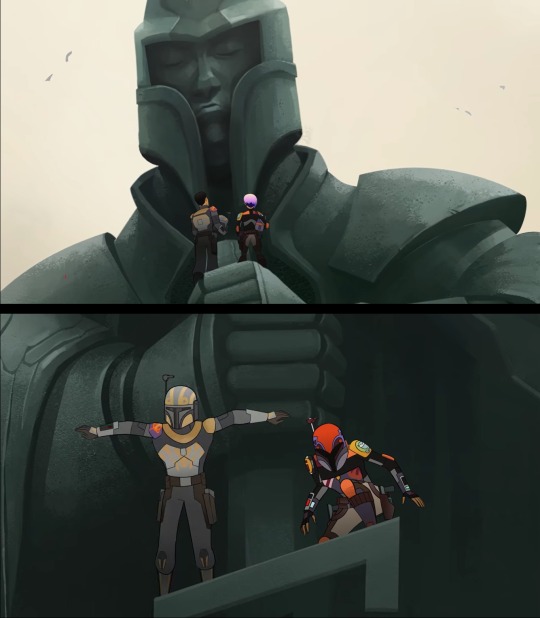
The statue of Tarre Vizsla though wasn’t presented in full details, clearly was built to represent the legendary Mandalorian holding sword blade down that brings to mind the medieval-like knights.
The Mandalorian
follows the The Clone Wars and Rebels take on Mandalorian culture with an even greater importance put on Darksaber and its meaning for warriors. The show treats Darksaber not only as an ancient relic and as a valid claim to the “throne”, but also as mystical item that may not accept its wielder like it did with Paz Vizsla (though this put under question all previously Mandalorians using the sword who were far away from heroic side of characters) and may even be cursed, as said Armorer:
If, however, it is not won in combat and falls into the hands of the undeserving, it will be a curse unto the nation. Mandalore will be laid to waste and its people scattered to the four winds”
Looking at the sources, it can’t be argued that some major cultural changes happened to Mandalorians and the further from Taung hegemony era, the swords became more prominent and in some cases, like Darksaber, are vital to secure “line of succession”. This shift is as much about weapons as about warriors themselves, as modern Mandalorian society is dominated by humans - although how much of an important role religion (Kad Ha’rangir) played in this change is up to debate.
Even if Taung society living on Roon used swords - whatever as weapons or ritual objects - during Mandalorian era this kind of weaponary is hardly seen used by confirmed Taung warriors (BHC so far is an exception) while modern human Mandalorians moved away from the axes in favor of swords, especially Darksaber.
[Next part] further sources to dispute
SIDENOTES:
[3] I say supposedly, as I support Jango Fett’s doubt it was written by Tor Vizsla. C’mon, can anyone imagine Legends!Tor writing anything like that?
[4] For better comparison, the typical Crusader and Neo-Crusader armors look like this

Ordo’s own armor resembles the Neo-Crusader type however it seems to still keep some elements from the previous kind. Ordo himself took part in the Mandalorian Wars yet as a veteran he was bitter about how his people from proud warriors degraded into mercenaries and criminals. When he became a Mandalore, he tried to bring Mandalorians back to the honorable ways which is why I personally count him more as example of pre-Neo Crusader Mandalorian culture.
#star wars#cienie's take on mandalorian culture#mandalorians#taungs#darksaber#bounty hunter code#mandalorian religion#cienie's research#i think the next part will be the last in regard to kad ha'rangir
22 notes
·
View notes
Text
Taungsdays, Am I Right?
For Bo-Katan Week Day 5, Mand’alor
Characters: Axe Woves, The Armorer, Bo-Katan Kryze, Original Mandalorian Characters (background)
Pairings: Bo-Katan Kryze/The Armorer, Bo-Katan Kryze & Axe Woves, Axe Woves & The Armorer
Warnings: none
Notes: Look, listen, I’ve been reading nonstop between American government books, and everything I can find about the Taungs and old Mandalorian ruling structures. But, keep in mind, I am not a wise man. And my pen ran out of ink during all my notes, so I had to just. . . stop taking notes because I have no other pen, and I can’t concentrate without handwritten notes lmao. Maybe this counts as more of a character study. And it’s a little shorter than I’d like, but I think ending it where I did is the best option right now
Word Count: 1,929
AO3 Link: Here!
“She does not stop often, does she?” The Armorer questioned to one of the few who held the title of the Mand’alor’s most trusted. The mug of pot soup was passed towards Axe Woves as she lowered herself into a seat beside him.
Bo-Katan had been moving nonstop as of late, between sitting through the many different politics required of a new world leader, expanding the new rule to the rest of the Mandalore system, and ensuring her people were still given an equal amount of her time, between training, to rebuilding, and even just to aid them in small errands, Bo-Katan Kryze was a blur of near constant movement. They only had nineteen hours in a cycle in the system, and yet, she was often busy for nearly fifteen hours each day.
“It’s how she’s survived,” Axe surmised, taking the offered food with quiet thanks. His gaze did not move from the woman in the middle of the small arena, how she walked the younglings and even some of the children of the watch through a training exercise, stopping often to fix posture and offer words of encouragement between them all. “Kriff, might as well be in her DNA,”
The light that filtered into the cavern from the green hued crystal above highlighted the yellow in her eyes, irises seemingly caught in an illuminated glow as she looked towards her two spectators with a small smile puling at her lips.
“Would you elaborate?” The woman requested as she settled herself in, nodding her head in acknowledgment of a youngling that seemed excited by her presence.
“It was always a rumor, that some of the oldest clans may have descended from the Taungs, our Progenitors,” The next time the Mand’alor glanced at them, her eyes seemed a warm amber, than the illuminated yellow they had been. “Their songs have been sung for eons, though much has been lost to history,”
“The Taungs used warfare as a personal honor, but also to appease a god,” His gloved hand brushed over his stubble as he racked his brain for the name.
“Ka Ha’rangir,” The Armorer supplied. The Children of the Watch did not have as much information as many of the Niteowls who had lived their history on the front-most lines, their convert had followed in the paths that were laid out by Mandalore the first themself.
“Yes, and like with most religions based on an omnipotent being, there is a clearly defined ‘good’ and ‘bad’, for the Taungs, they strived to remove themselves from Arasuum’s temptation of stagnation and idleness. This was not a trait that died with the Taungs,” He gestured to the redhead that was now rolling on the floor with one of the children of the watch, giving a visual for how the moves she’d just taught would be used in combat.
“Under Mand’alor the Ultimate, when the Taungs truly started to accept other species among their ranks, cross breeding was frequent, though many humans had been, supposedly, unable to survive the birth of a Taung, even if the child was only half Taung. Not all of our oldest clans have survived from those days, it was mainly Riduuroks that kept bloodlines alive as well, so, while unlikely to have found a Mandalorian descended from the first,” When he gestured to Bo-Katan again, it was to the woman wrapped in a headlock, before her sharp teeth pierced through the flight suit and arm of her opponent, until they’d released.
“Even with less than a percentage of genetics that may have been passed down, they showed much more prominently in Bo-Katan, than they had in The Duchess Satine,” Axe had seen them both, and compared to Mandalorians’ they were obviously a different breed, in their own way. Even the Vizsla’s hadn’t been able to hold a flame to the traits of the Taungs that had stood out sharply in Kryze genetics.
“It is safe to assume that these traits have clung so tightly through the bloodline, that she is simply hardwired like a Taung,”
“She is still human though, is she not?” The Armorer finally questioned, watching as Bo-Katan helped put bacta on the Mandalorian’s arm she’d bitten, who she’d sent off for water before jumping back into the lesson.
“Without a doubt, and that has always been one of her flaws,” Axe shook his head “Worship and belief of Ka Ha’ragnir and Arasuum fell out of favor long before our time, though, with the way our lives, hers especially, have been led, I can understand some kind of base decline to the instincts of the Taungs. We have our songs, our ancient recordings, but we also have the behaviors passed from generation to generation about how our lives were to be lived and how to react.”
It was no secret that they’d all done unimaginable things in the name of survival, and their culture. It had always been written off as their bullheadedness and their way of life, though many had forgotten that it had once quite literally been in their blood. “Her flaw is not that she is human,” The Armorer’s voice was slow, steady, trying to ensure that she’d heard him correctly, while making sure her own point was known.
“No, no. That isn’t her flaw, but the activity is. When she… for lack of a better term: forgets that she’s human. The Taungs may not have needed to rest as often, and that may have been a leading factor to their belief and devotion to Ka Ha’ragnir and their pursuance of growth and change that she’s chasing subconsciously,”
“You seem to have given this a great deal of introspection,” The Armorer noted. “We have not had a great deal of resources about our earliest ancestors, aside from the creed and the moments in history w have found that had defined a need for our existence as well,”
“Being home has granted me more than my share of time to learn. We are all given an opportunity our ancestors had not, to be good at something other than war,” It was an echo of Bo-Katan’s own words. Axe was becoming a scholar and a rather skilled diplomat, now that they had access to records from the New Republic, and the old records from the Imperial Academy on Mandalore as well. He finally had the time to sit down and stimulate his brain with history, over battle strategies and espionage. “Lady Kryze has quite the extensive knowledge as well, more so about the more… dry aspects of our history. She has not limited herself to the governing past, or the past of warfare, but has extensive details about our prior trade, exports, and many other details I am sure had sparked her interest before the New Mandalorian rule had her splitting off.”
“What are we talking about?” Bo-Katan questioned as she dropped herself into a lower level of seating in front of the two, armored back pressed into both of their legs as she leaned back and actually sat for the first time all day.
“You,” The Armorer provided, a gloved hand reaching to smooth out loose strands of sweat slick hair to calm any rising thoughts she could see gathering beneath a furrowed brow.
“Why are we talking about me?” The redhead questioned as the convert member shed bitten earlier brought over an extra canteen of water, receiving a quiet thanks as the rest of the class let out, either back to the surface, their mentors, or their duties.
“You are a big part of Mandalorian history,” Axe pointed out, when Bo-Katan’s lips parted to argue the point, he was quick to continue. “Think about it, Bo. For the first time in our history, Mandalorians are not at war, not with each other, not with the dar’jetti, and not with the republic. Our people are united under a common banner, and for the first time since our Progenitors, the Mythosaur is back, and has revealed itself to only you, You have wielded the dark saber on more than one occasion, and yet, you have proven that a successful Mand’alor does not need to hold a weapon to be successful. You’ve led us to a new age,”
Bo-Katan shifted uncomfortably against their legs as she drank and wiped sweat away from her brow. “That’s a lot,” The woman shed her gloves and reached to scratch at the back of her neck with sharer than usual nails. “But I didn’t do it alone, and I never would be able to do any of it, without either of you, and without Din Djarin, or without Paz.” There were many among their ranks that had given much more than her, had sacrificed more of themselves than her in the pursuit of their home.
“That does not exclude your leadership and influence through it all, however,” The Armorer reminded, causing the redhead to nod as she processed.
“This is true, I supppose,” A pause, and a small smile. “Mandalorians are becoming something new,”
“Like those who were formed directly from the Taungs,” Axe chimed in, bringing an excitable expression from the Mand’alor.
“That’s actually so true,” There was a knowing smirk on Axe’s lips as he forced his elbow into The Armorer’s side, as their Mand’alor went into an extensive tangent about their similarities to the first Mandalorians, and the fall of the Taungs that had secured their system, how, in regaining their planets and moons from Imperial control, they were almost like the crusaders of old. It was almost comical, the way the woman of near fifty standard years could turn into an excitable teenager the moment their history was mentioned. It was a side that he’d never seen much of until they came home, but one he enjoyed nonetheless, as he’d always find something new to learn from her.
Koska joined the trio some time later, her arm draping around The Armorer’s shoulders as she dropped her chin on Axe’s shoulder, listening as the Mand’alor spun the stories of their people with excited hand gestures and the like.
Truthfully, it was the most down-time Bo-Katan had given herself since the most recent bout of hyper-activity. She kept herself leaning on The Armorer and Axe’s legs, one arm tossed back to rest on The Armorer’s thigh as she explained the Taungs’ last stand, and the different ways their culture had branched off since the split.
Their history was sprinkled with the hazards and the costs of war and destruction, even her sister, who’d done all she could to do better by their people, had not achieved such a feat. Many of the prior Mand’alor’s held titles that would have them remembered for eons, such as Mand’alor the first, Mand’alor the Indomitable, Mand’alor the Ultimate, and Mind’alor the Great.Bo-Katan would be remembered as the World Strider, the Mandalorian who brought their people back to a life like under the rule of Mand’alor the Uniter.
Their system found safety and security under her rule, and they found a boom in hundreds of those oppressed by the Empire to create new clans, searching for a people and a purpose among their ranks.
Mandalore was thriving once more under their rule, because it wasn’t truly hers alone, no matter who they’d allowed to hold the title, they had each poured themselves to get to this point, and as long as she was standing, Bo-Katan would ensure their songs would never be lost, that they would be seen not as just another soldier in a war, but as the foundation of their rebirth.
#bo katan kryze#the armorer#the mandalorian#star wars#bo katan x the armorer#nitearmor#the mandalorian season 3#Axe Woves#Taungs#Ka Ha'ragnir#Arasuum#Mandalorian Culture#Bo-Katan Is A Descendant Of The Taungs#BKW 2023#Bo-Katan Week#Bo-Katan Week 2023
14 notes
·
View notes
Text

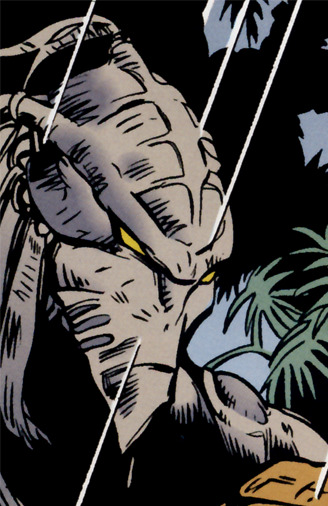

Taung appreciation post
Manda’lor the ultimate
#mandalorian culture#mandalorians#mandalorian#star wars eu#star wars expanded universe#Manda’lor the ultimate#taung#mandalor#manda’lor
25 notes
·
View notes
Text

Ubicado en la cima de un volcán, a 1,518 metros sobre el nivel del mar, Taung Kalat es considerado uno de los templos más remotos del mundo y un patrimonio cultural de Myanmar.
12 notes
·
View notes
Text

I learned about the Taung child , an Australopithecus Africanus child found in the Taung region of South Africa. The Taung are also ancient primates and culture in Star War.
I do enjoy the relatively obscure source for Star Wars inspiration.
9 notes
·
View notes
Text


hello yes I just spent the last three hours coming up with a taung pantheon and a shrine to them that's still up in the bowels of Coruscant for clones to find and wake up ancient Mandalorian gods to get their righteous retribution against the Senate and palpafucker.
there's tan (loyalty) marble floor, red (respect) carpets, and bronze (nobility) statues of the seven gods. in the center, there's a platform with a bronze water font and on either side of the platform is stairs leading down to the main area.
during the clone wars, the main area and half the stairs are flooded with super dirty fucking water and there's mud, fungus, moss, and dust everywhere. there's also algae in the water font.
taung ritual is inscribed on the doors in pictographs - washing your (already clean) face and hands in the font and taking a sip of the water before bowing to each of the minor gods, prostrating before the statue of Lorr, and then praying while kneeling or seated.
because the font is bronze, it does disinfect the water by itself, but space algae. it's still safe for the clones to drink but they don't worship. mainly they hang out on the platform, sitting in the moss and mud and dipping their toes in the water while gossipping. the whole area just has a calming affect on them and no one but them and a handful of trusted people who told them about it or who they led to it can find the shrine.
a shiny is the one who wakes up the gods, following the ritual on a dare and then "oh hey a very distant descendant of our past worshippers hi there" "commanderrrrr the statues are talking" "oh wow we've been in stasis a long fucking time i need something to do, hey give me your most impossible wish list items and we'll distribute the tasks according to our aspects, as a favor for waking us up, no strings" "uhhhhh i guess end the war and get us more food and caf and medical supplies - oh and make the senators give us citizenship and backpay!" "got it, no problem - actually slight problem, we seem to be stuck here, how do you and your brothers feel about possession?" "i guess if it helps our other brothers go for it? wait let me check with my superiors first, fox can i get possessed by an ancient god?" "whAT [unintelligible cursing in increasing volume]" "sorry, i think that means no"
and then fox volunteers himself to get possessed first because he's desperate to change things and his gut tells him these gods are legit and then Lorr possesses him and is like "hm something feels off [breaks chip] there we go" and then they go kill palpatine bc "what's a sith lord?" "uses the mystical omnipresent energy field called the force for evil" "oh okay it's that guy" "whAT"
#/incoherent noises/#star wars the clone wars#coruscant guard#taung pantheon au#star wars taung#image descriptions needed
45 notes
·
View notes
Text
Mandalorian Dating Systems and Calendars
After spending the whole afternoon developing a dating and calendar system for the Mando-centric fic I’m currently writing, I ended up with not one, but two different systems (and some headcanons about the Galactic Republic dating system).
For simplicity’s sake let’s assume the Galactic Republic uses predominantly the year of the Ruusan Reformation epoch for their dating system. The year 0 ARR (After the Ruusan Reformation) corresponds to the year 1000 BBY (Before the Battle of Yavin). The calendar system is the Coruscant-based standard one with the year’s length being 368 days. The date notation is yyyy.ddd (e.g. 948.126 ARR is the 126th day of the year 948 After the Ruusan Reformation).
Mandalore was founded in 9991 BBY so they began their dating system with the Founding of Mandalore (FoM). I headcanon the Taungs decided to keep their calendar system unchanged after leaving Coruscant and eventually colonizing Mandalore which means a Mandalorian year has 368 days just like the Galactic Republic one. Unlike the latter, however, the Mandalorian year begins 67 days later (e.g. 9253.1 FoM, the first day of the year 9253 since the Founding of Mandalore would be 262.68 ARR).
Why a 67 days discrepancy? It would be weirder if they were synchronised.
Since I cannot imagine the New Mandalorians would want to use the FoM as their dating system, and considering the movement began after the Mandalorian Excision, the New Mandalorian Calendar (NMC) system will use the Excision (738 BBY, 262 ARR, 9253 FoM) as year 0. The length of the year and the New Year are identical to the traditional Mandalorian calendar system.
So basically
0 BBY = 9991 FoM = 738 NMC = 1000 ARR
Cheat sheet:
BBY: Before the Battle of Yavin
FoM: Foundation of Mandalore
NMC: New Mandalorian Calendar
ARR: After the Ruusan Reformation
Some notable dates of Legend/Disney canon events in the various dating systems:
934 ARR (9925 FoM, 672 NMC, 66 BBY) Jango Fett is born
940 ARR (9931 FoM, 678 NMC, 60 BBY) the Mandalorian Civil War begins
943 ARR (9934 FoM, 681 NMC, 57 BBY) Obi-wan Kenobi is born
948 ARR (9939 FoM, 686 NMC, 52 BBY) the Battle of Korda VI is fought; Sheev Palpatine is elected Senator
955 ARR (9946 FoM, 693 NMC, 45 BBY) Obi-wan Kenobi becomes Master Jinn’s padawan
956 ARR (9947 FoM, 694 NMC, 44 BBY) the Battle of Galidraan is fought; the Stark Hyperspace War begins
959 ARR (9950 FoM, 697 NMC, 41 BBY) Anakin Skywalker is born
961 ARR (9952 FoM, 699 NMC, 39 BBY) Anakin and Shmi Skywalker are sold to Gardulla and begin their lives on Tatooine
#hyperfixating on trivial details instead of writing the actual fic 101#star wars#mandalore#mandalorian#new mandalorians#calendar system#dating system#ruusan reformation#mandalorian excision#taung#galactic republic#galactic standard calendar
20 notes
·
View notes
Text
Zwe Yan Naing - Artista Birmano ¿Simpatizante de los Premios Nobel?
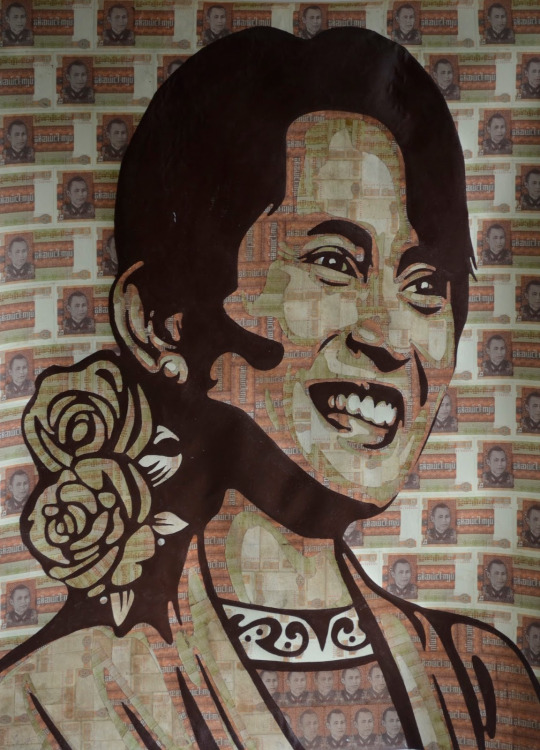
#Zwe Yan Naing nació en Taung Goke estado de Rakhine Birmania en 1984. Estudió en la Escuela Estatal de Bellas Artes en Yangon#¿Esta es la imagen y algunos datos (O no) la “Historia” la pones tú? ¡La tuya! ¿Lo harás...?#¿Premio Nobel?
7 notes
·
View notes
Note
Okay I gotta ask about 'What the Kriff do you want' that just made me laugh. Hilarious WIP title.
YES! I was hoping someone would ask about this one!
It's a prequel to "What The Force Wants". It follows the Taung evacuation of Coruscant. Or at least this one clan of Taung, they crash land on a primitive inhabited planet (of an alien species of my own creation) leaving a fraction of the clan alive. Ora'Ore, a Taung who has just recently reached majority, was injured in the crash leaving him partially blind.
Enter Diinal the daughter of the tribe's leaders. She is fascinated by the Taung and goes out of her way to involve herself in their daily activities, despite the vast language barrier.
Ora'Ore wants nothing to do with her, she reminds him too much of the zhell in her appearance. Even though the other Taung have no such issue. (it's the first red flag of blindness affecting him) Diinal refuses to leave him alone.
No matter what Ora'Ore does she comes back. "What the kriff do you want?" is what he asks every time he sees her approach him.
2 notes
·
View notes
Text

The Taung need more lore and screen time
But not from Disney
2 notes
·
View notes
Text
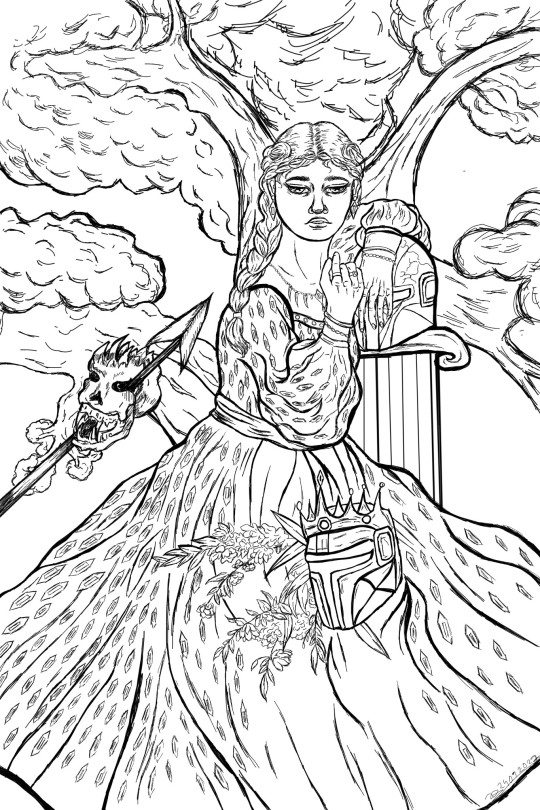
A WiP for my new art piece from Mando worldbuilding and canon divergence story I've been thinking about for a while!
I'm super proud of this lineart, I tried to incorporate as much Mandalorian elements I could think about lol (the spear with a Taung skull, kar'ta beskar pattern, helmets), I really tried 😅
I hope you also like the Mandalorian royalcore vibes it gives off!
Don't forget to LIKE and REBLOG 💕💕💕
#crackedopen art#my art#mandalorian#mandalorians#mandalorian culture#royalcore#star wars fanart#star wars#mando#mandalore#taung#taungs#lineart#art wip
8 notes
·
View notes
Text
Cienie’s take on Mandalorian Culture: Kad Ha’rangir and mandalorian traditional weapons, p. 5
part 1 — part 2 — part 3 -- part 4
Caution: I have never personally played The Old Republic MMORPG game and all my knowledge about Mandalorians of that era comes from tie-in material including those published on dedicated to SWTOR sites and watching playthrough videos, especially of the last patch, Legacy of the Sith. Keeping that in mind, let’s wrap up the final part.
The Old Republic MMORPG game takes place a few hundred years after the regime of Mandalore the Indomitable, The Ultimate and the Preserver (Wookiepedia claims the story of SWTOR currently covers the era of 3643–3626 BBY). For the first(?) time an in-universe source contemporary with the events taking place directly mentions Kad Ha’rangir and praying practice:
The Fall of Mandalore the Vindicated
Firsthand account from Ralia of Clan Lok:
The Skytroopers surrounded us. Two dozen, blasters aimed at our heads. We had already begun our death roar.
And then Mandalore the Vindicated cut through them, scattering their metal parts. He ordered us to rejoin the clan and leave the Skytroopers to him. But the droids had called for backup; suddenly, dozens were swarming him.
Mandalore dismantled them two at a time with a war cry like thunder. They kept coming, waves and waves, till we could no longer see him. I started to charge forward, but Droga stopped me. “He’s already gone.”
He was Ardus Lok. My brother, our Mand’alor. And he fell to machines. He will not be honored.
I pray to Kad Ha’rangir this pointless war will end soon.
This account gives us a lot of interesting details about the Ralia of Clan Lok’s mindset. On one hand, “he fell to the machine. He will not be honored” line fit with what game itself presented by Torian Cadera

and Khomo Fett's mocking saying

Which implies she and similar minded warriors followed very harsh rules according to which dying in battle against machines may bring dishonor - even if Mandalore sacrificed himself to save his people, as Ralia herself said: He ordered us to rejoin the clan and leave the Skytroopers to him.
However the author of this account didn’t pray to Kad Ha’rangir to acknowledge and/or have mercy on the soul of the “dishonored” clan brother but prayed for pointless war to end soon. Which is surprising, given that War was a central part of her culture - approximately three hundred ago, Taungs and Neo Crusaders considered War to be divine and SWTOR’s lore object outright says “War is the Mandalorians’ way of life”, while describing Mandalorians as “trained from birth to fight in battle”, who “embrace conflict and admire strength” and “believe confrontation is required for growth — on the personal, as well as the cultural level."
Mandalorian praying for war to end seems to be acting against the most basic principles on which the whole warrior culture is built. Even more surprising is the fact, the prayer was said to Kad Ha’rangir, the god known as Destructor who demanded from his followers to face challenges and trials in the first place and not, for example, to Arasuum, the god supposedly opposite to Destructor. And yes, the Mandalorians: People and Culture and Death Watch Manifesto call Arasuum the god of stagnation and idle consumption however in the traditional understanding of myth, opposition to destruction wouldn’t actually mean prosperity as time not dominated by war?
Showdown on Ruhnuk (included in Legacy of the Sith, 2023) went even further with the religious aspect of Mandalorian culture by introducing the clan Ha’rangir, whose members are said to be descended from the god Kad Ha’rangir himself. Within the game itself, this information is passed to player by Lane Vizla:

"Clan Ha'rangir claims they 're descended from Kad Ha'rangir, an old Mandalorian god of destruction."
SW:TOR provided also a codex entry for Ha’rangir Clan (x):
Named for Kad Ha'rangir, the ancient Mandalorian god of destruction and bringer of change and growth, Clan Ha'rangir was founded by Mandalorians who believed their people were being weakened by cowardice and inaction. The clan began a bloody expansion called "Ha'rangir's Path" in the latter half of 3732 BBY. Their early success encouraged more raids and occupations, which earned the clan a fortune in resources. This vast war chest sustained Clan Ha'rangir during the decades of reactionary conflict that followed.
Their empire building peaked in the 3600's and slowly declined as newer generations of Clan Ha'rangir avoided the front lines, preferring instead to manage and expand their wealth. Once formidable conquerors, Clan Ha'rangir's power today resides in the credits they command, rather than their military might. Some within their ranks, however, are questioning their role within the galaxy, perhaps yearning for a return to their expansionist ways.
Lane Vizsla describes this clan as “old money, with an even older name”

However Lane notes also how the fame, prestige and credits corrupted those Mandalorians, including current leader, the Kur Ha’rangir.

Decades of that kind of notoriety, power, and credits have given them quite that inflated self-image.

He does whatever he wants - no matter how dishonorable - and his name and his money pay for everyone to ignore it.

They consider it an insult if you don't recognize their prestigious history. They consider it a threat if you don't give them the respect they demand.
Granted, Lane Vizla isn’t an objective source, as she holds personal grudge against Kur Ha’rangir for killing her brother in an unfair duel over a trivial matter[12], yet what game presented on screen (Kur’s treatment of basilisk war droids) so far supports Lane’s claim. Even Codex entry for leader of Ha’rangir clan (x) highlight his egotistical and arrogant nature:
Ruthless, arrogant, and egotistical, Kur Ha'rangir embodies all of the traits that the members of his clan, Clan Ha'rangir, consider important. Claiming to descend from Kad Ha'rangir, the old Mandalorian god, Kur sees his clan as the supreme embodiment of Mandalorian strength and power. To reflect Clan Ha'rangir's status, Kur believes that he should possess the strongest and most powerful weapons.
Although Basilisk war droids--the infamous Mandalorian mounts that wreaked havoc across the galaxy during the Great Sith War and the Mandalorian Wars--are exceedingly rare, Kur Ha'rangir has no interest in preserving them for future generations. His only goal is to collect and continually improve the best of them, even if it means sacrificing the increasingly limited number of Basilisk droids for their parts.
As the number of available Basilisk droids dwindles, Kur has turned his attention to learning how to build the war droids--a craft that was lost when the droids' original creators destroyed their own planet. Legend tells of beacons, full of schematics and construction plans, that were scattered across the galaxy when Basilisk was destroyed, and although Clan Ha'rangir has pledged themselves to fight alongside Heta Kol and the Hidden Chain, Kur has not let their desires interfere with his own obsession.
There are plenty of conclusions that can be drawn from the above sources. The most important one is that Kad Ha’rangir is known as an old Mandalorian god of Destruction and whose importance remains strong enough to allow the “descendants” bathe in his glory solely for supposedly sharing the same blood and surname. We still can’t be sure if original Mandalorians worshiped this deity under this exact name (or if even knew him at all), but if Kad was part of Taung mythology, then we can assume the mythological knowledge (religion) was passed down to newcomers before Taung died out. This is actually quite an interesting detail in regard to religious reformation that happened before The Sith War, when original Crusaders are said to change their customs and start worshiping War itself.
The second vital information is how Mandalorian society has changed by the last three to four hundred years. For one, a clan like Ha’rangir isn’t held at this point in respect due to members’ individual deeds or military might but solely for supposedly having a prestige ancestor and money to cover for their dishonor behavior. Though we do not have that many sources about original Mandalorians, I think it is safe to say clan Ha’rangir is the beginning of the emerging aristocracy while also an antithesis of Taung warrior society. Especially in the matter of equality of clans, personal honor (prestige) and money.
Taungs, as far as we know, respected hierarchy but their social structures were built on warriors’ personal achievements not who their forefathers were. They did seem to hold past ancestors (clan members) in high regard[13], as at some point in the past they renamed themselves from Shadow Warriors to Mandalorians in honor of their legendary “warrior king”, Mandalore the First. However no one so far claimed to be a direct descendant of said leader or gods nor the leadership was passed down on such a basis. The title of Mandal’or is outright stated to not be democracy nor hereditary bestowen - which means only the person who dared to take the title (responsibility) and proved their worth may lead other warriors. This approach to the leadership was mentioned in SWTOR tie-in source, the The Old Republic Encyclopedia:

and summarized by Canderous Ordo: “When our leader falls in battle, the most worthy takes his place”. (Star Wars Miniatures)
Similar approach could be seen in regard to hierarchy between clans and its members. For example, Galaxy At War Sourcebook describes Taung society as “clan-based nomadic culture” in which ”veterans of successful battles are held in high regard, to such an extent that they are de facto leaders of their communities. Only the leader of all the Mandalorians, known simply as Mandalore, holds greater sway with the clans.”
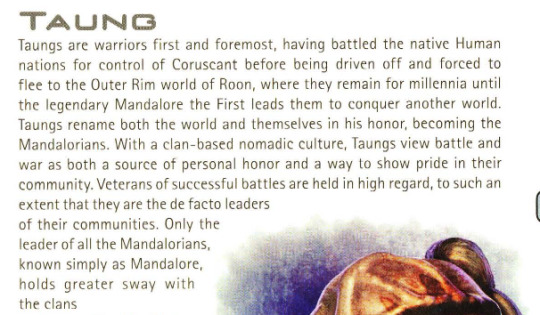
while SW:TOR Encyclopedia states “Although clans may have ties or rivalries with other clans, there is no formal hierarchy. All clan chieftains report directly to the Mandalore”.
(The lack of formal hierarchy wll change overtime, as some old and/or powerful mandalorian clans like Vizsla and Kryze turned into Houses. The sources so far did not provide enough data about inner workings of said Houses, although Sabine’s introduction in Rebels: Protectors of Concord Dawn [S02E13] as “I'm Clan Wren, House Vizsla” implies other, lesser(?) clans are subject to them. Similarly, House Kryze at some point became officially acknowledged as the Royal Family that ruled Mandalore before and during the Clone Wars. Simultaneously, the number of clans is not constant and limited, as sources provide examples of new clans formed during different eras.)
At the same time, the Mandalore, clan leaders and veterans - the broadly understood "ruling class" - may be challenged by anyone and according to the law, the honorable duel will officially settle the conflict[14]. This law apparently survived to modern times as could be seen in
Death Watch Manifesto: “to ensure we would be led by the most powerful, we decreed that any warrior could challenge the Secret Mandalore for leadership of Death Watch”

and The Clone Wars TV animated series when Maul challenged Pre Vizsla to a fight over control of Mandalore & Death Watch:
Almec: “Clearly you are powerful, but how can two of you overthrow Vizsla and his supporters?”
Maul: “Vizsla is a soldier and, like every soldier, he is bound by honor. I will challenge him to single combat in front of his men. He will not deny me.”
Almec: “Hmm. If you defeat him, according to the ancient laws of Mandalore, his soldiers will be honor-bound to follow you.” [TCW S05E15: Shades of Reason]
All of this implies that Mandalore and even the highly renewed veterans do not stand above the law - and maybe, ironically, are even more bound to follow it, as their honor is at stake.
Now, Ha’rangir clan is said to get away with dishonorable act during an official duel because of the religious connection and money and in all fairness, this speaks a lot about Mandalorians of that time. The roots of this corruption however reach the end of the Mandalorian Wars and the following decade(s) which brings me to another vital point. How exactly Ha’rangir clan got their fortune?
Lane Vizla described members of said clan as “old money with an even older name”. while Shae Vizla further explained:
Player: Clan Ha’rangir?
Shae Vizla: I figured we’d see them around. Like I said before, they’re old money. Many clans got rich from plunder during the Mandalorian Wars generations ago. They want those days back, and Heta’s the answer.
If we agree that Ha’rangir clan got rich from plunder during the Mandalorian Wars, the clan dates to at least the last phase of Taung era (and Lane suggests the clan is even older than that). As much as it is true that Crusaders and Neo-Crusaders raided and robbed many planets, Taungs weren’t exactly focused on material wealth. Yes, they prized advanced technology and generally understood weapons were always at the top of list to steal, but money and similar goods? KotOR Campaign Guide states that “trade within Mandalorian communities is based on barter, with jewelry and precious metals used as portable commodities alongside weapons and armor” and that Mandalorians were familiar with galaxy currency however beside that one paragraph, the traditional culture didn’t seem to hold material goods other than an armor in any real regard, as only personal achievements allowed warrior to rise in the social hierarchy.

Thinking about this matter, KotOR tie-in materials allowed us to dwell into the Mandalorian mindset and majority if not all named Mandalorian characters showed no real concern over the money.
In KotOR: War, new recruits were provided with armor and weapons, warriors did not complain about living in harsh, frontline conditions even while raising children. Ko Sornell's advice to a newcomer (Zayne) was “find some wall to lean against. During invasions we sleep in armor. You'll get used to it” [KotOR:War #2]
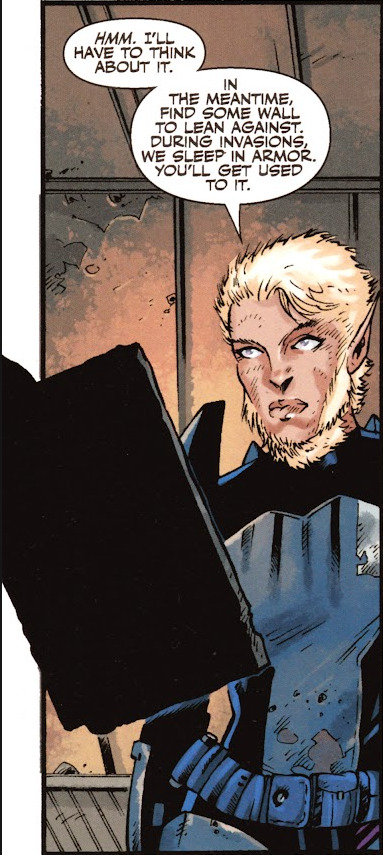
Another example comes from Interference short story taking place in early 3963 B.B.Y. When Mandalorians were faced with republic propaganda broadcasting on their communication frequency, taunting with luxury, even talking about how the Republic has “Real beds. Running water” in contrast to mandalorian camps and finally promising wealth:
And it is an offer. They say that Mandalorians deal with things in a Mandalorian way. Well, the same is true of the Republic. And what is the Republic at heart, if not first and foremost, a vehicle for the enrichment of all peoples? There isn't any reason at all why the forces of Mandalore can't have a seat at the table like anyone else.
And so the offer is this: The Republic would welcome a cessation of hostilities with the Mando'ade. In return, the Senate would be willing to commit a share of all taxation from Republic planets and hyperspace lanes currently under Mandalorian occupation to go to the occupiers. That's right: the spoils of war, to stop the war.
It is a fair price, and one that should more than satisfy all your requirements. With your victories in these weeks, your honor has been restored. The galaxy knows it. The Jedi did nothing to stop you; they know it. And you will have the prize -- part of the wealth of these stars, without having to continue to enforce your will on them. You'll be free to explore your options elsewhere, in directions away from the Republic -- and you'll be better funded to be able to do it. “
Ko Sornell reported to her superior, Cassus Fett, this:
Yes, Cassus, I responded already. I used the transmitter here on Zongorlu.
I know I should have waited. Who is Koblus Sornell, anyway? Just a warrior. A signals expert, but a warrior. A Mandalorian warrior…
... and as a Mandalorian warrior, their "choice" was really no choice at all. I spoke for all of us: Their "bargain" was ridiculous.
Think about it: They could have a glorious battle, a true measure of what we're worth. That's a bargain. Instead, they're trying to choose -- a bribe? To buy peace like a peasant at a shop? All it costs is whatever guts they ever had.
And they thought we might agree to it! Whatever gave them that idea?
Just like with this "Captain Goodvalor" business. Pretending to be the victor of great battles -- that's insulting enough all on its own. But big talk about what they can do, how big their forces are?
Lies about people leaving our side? Did they really think any true Mandalorian would listen?
Do they really fear us so little?
Cassus Fett himself showed little care for wealth, as can be seen in short interaction with Gromar [KotOR #23].
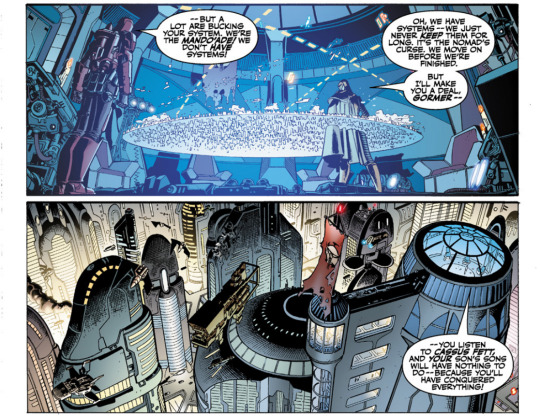
"--you listen to Cassus Fett and your son's sons will have nothing to do -- because you'll have concquered everything!"
Cassus admitted Mandalorians didn’t make full use of the resources of the conquered lands because they rarely stayed in one place for long (the curse of nomad life, as he called it) however he did not promise wealth to his subordinate but that Mandalorians are gonna conquer the whole galaxy leaving nothing for new generations.
Canderous Ordo mentioned in some of his game dialogues the fortunes (wealth):
Canderous: You want to hear tales of my exploits? Of the wars I've seen and fought, the enemies I've seen die by my hand? Heh, sure, I'll humor you. My name's Canderous of the Mandalorian clan Ordo. I've been fighting across the galaxy for 40 of your years. For my people it's the honor and glory of battle that rules us. It's through combat that we prove our worth, gain renown and make our fortunes. [KotOR game]
or
Mandalore: The Republic thinks my people are dead, scattered. They are wrong. You should have destroyed us when you had the chance. As long as one Mandalorian lives, we will survive. Our honor, fortunes, and lives revolve around battle. From our earliest history, this has been our way, as it will be, always. [KotOR 2 game]
however other tales made it clear money itself did not have the same value as armor, weapon and basilisk droids, as losing those three (cultural) things hurted defeated Mandalorians the most:
Canderous: The war we had with the Republic was supposed to be the most glorious battle of our history, but… it was a very costly one. I guess we didn't think of how much we could lose in it. [...] There weren't many of us left after that last battle. Mandalore himself was killed at the hands of the Jedi Revan. The best of us could not defeat him! After that last battle, those of us that survived were stripped of our weapons, our armor, and our Basilisks. Revan's forces destroyed them while we were forced to watch. Those who hadn't fled earlier were left with nothing to call their own: no weapons, no armor… only the honor of having fought in the battle we just lost. For many this was not enough. While the rest of us were sent into exile on the Outer Rim, they tried to relive the old days – raiding worlds. They're nothing more than bandits now. [KotOR game]
Canderous specifically said “Those who hadn't fled earlier were left with nothing to call their own: no weapons, no armor” so clearly, the “warrior equipment” is the wealth that Mandalorians cared for, not credits or other material luxuries. Similarly approach was seen a decade later in Mandalorian Camp on Dxun:
That idiot Kumus will be working off his shame for the rest of his days. Equipment eaten by cannoks - it would have been better if he'd let the jungle take him. [KotOR II]
However, as Canderous mentioned, after the Mandalorian Wars, this mindset changed in favor of money. Some Mandalorians turned into mercenaries, some kept raiding worlds, some turned into bandits attacking simple farmers. This sentiment was repeat by Veela from The Old Republic: Revan:
“When Revan hid Mandalore`s Mask, most of our people scattered in disgrace. But some of us refused to give up. We stayed behind to look for what was lost instead of running off to become mercenaries and hired thugs.”
Similar statements comes from History of the Mandalorians:
“Following their failed campaign, the Crusaders found a new object of worship -- the almighty credits. Decimated and embittered, the surviving Mandalorian warriors turned ruthlessly mercenary in order to survive. Informally called the Mandalorian Merc, these individuals hired out their lethal talents to the highest bidders without regard to silly notions like justice, morals, and honor.”
So, did members of Ha’rangir Clan enriched themselves during the Mandalorian Wars, as Shae Vizla said, or did they get their fortune from post-war raids, as Codex Entry suggests? This is an important question in context: how old the clan truly is? Because there is a chance that the clan's origin grew into myth over the time, the same as their “cultural” role.
I mean, Canderous and Veela of clan Ordo were eyewitnesses of change happening in their society while Shae Vizla and contemporary Mandalorians may only rely on knowledge passed down to them by their predecessors. Considering how Mandalorian people were broken and divided after war, it is quite possible that a lot of historical knowledge was lost or misrepresented, even on purpose.
At the same time, there were attempts to bring back Mandalorians to their honorable ways. The best known example is Canderous Ordo, who for his efforts earned the title Mandalore the Preserver. In KotOR II: Sith Lords, he said “Many Mandalorians have fallen from the path of honor and are now no more than common mercenaries. But that is changing” yet despite Ordo’s best intentions, the unity of Mandalorian clans is much more fragile than what it was under Taung leadership. But if Canderous could dedicate his life to rebuilding Mandalorian society under his banner (against Sith as Revan wanted), then logically thinking there could be more reformators like him. Which is another possibility to see Kad Ha’rangir. Not as a literal deity but actual historical figure who could renamed himself in honor of the warrior god[15], either presenting himself as “chosen” warrior / tool or maybe even as the god’s prophet of some sort or whose fame (interpretation of warrior culture) overtime grew into a myth that benefited the entire clan. TOR game presented us with Mandalorians such as Kur Ha’rangir and Arla Ha’rangir so Kad Ha’rangir easily could be a full name of real person who started the Ha’rangir family in the first place and whose person at some point merged into one with the mythical god in mandalorian collective consciousness. This brings back the question - did Taung truly knew Kad Ha’rangir under this exact name and not just, for example, simply as Ha’rangir?
As I hopefully established in previous parts, swords weren’t the traditional Mandalorian (Taung) weapon while the Kad Ha’rangir name, for the first time showed in in-universe source coexisting with the events taking place approximately 300 years after Taung died out. This is of course matter of game mechanics, but The Old Republic presents on screen
Mandalorian characters using commonly swords

lore entries like Mandalorian Relics: The Final Blade of Dunesa Rul (x)

[...] Rul's creations, prized within the Mandalorians, were often handed down from one clan leader to the next, but demand for new work was overwhelming. Rul was killed in an explosion during an altercation between Clan Mettir and Clan Ironstone, who sought to lay claim to a masterwork weapon--a durasteel dagger--he had created. Both clans were hunted down and destroyed in retaliation for the grievous loss. The dagger itself was never found.
Even the official duel between Mandalore the Avenger and Field Marshal Kol Heta was done with ceremonial swords
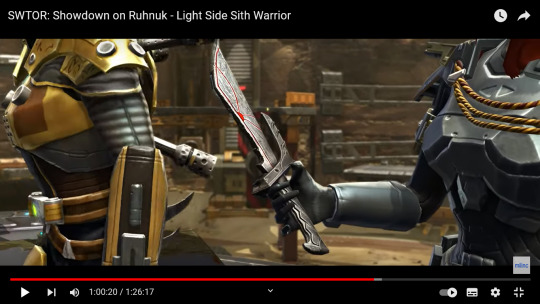
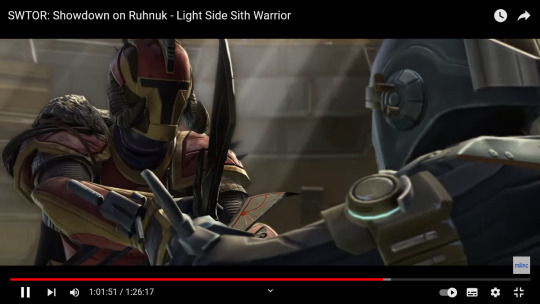
while so far the only axes I noticed are Gamorrean made (x)
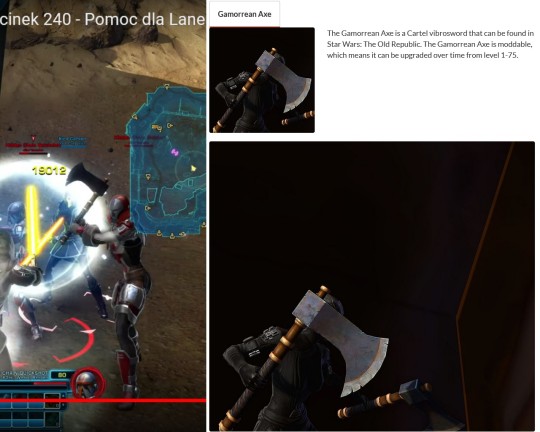
and vibro axe (x)
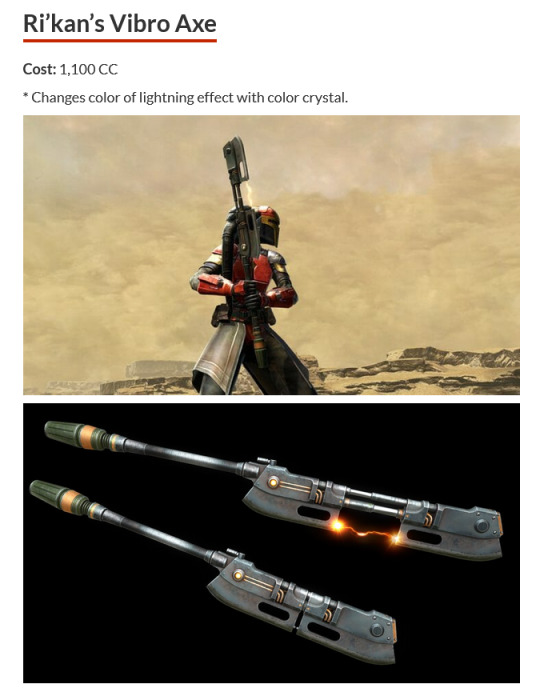
and none of those are even close in shape to traditional Mandalorian (Taung) ones. This kind of weapon seems to have lost its importance in the favor of swords/sabers, so if Kad Ha’rangir was a historical figure who either claimed or was hailed by others as descendant of an old god, he could be also a reason (impulse) for the switch from axes to swords. As in, Mandalorians considered him to have divine connections - or even be the embodiment of divine will - and started preferring swords as a symbol of their renewed faith to honor god. The mentioned in Codex Entry “a bloody expansion called "Ha'rangir's Path" in the latter half of 3732 BBY” fits well in that assumption and even could be treated as the approximate date of “religious (weapon) reformation”.
Like it was already mentioned, the unity between Mandalorian (human dominated) clans is a much more fragile matter than what we know about the Mandalorian society under leadership of the last two Taung rulers - the Indomitable and Ultimate. The conflict between old fashioned warriors and mercenaries started after Mandalorian Wars and will last to modern days however in The Old Republic game it took a surprising shape. The current conflict has divided Mandalorians into supporters of Mandalore the Avenger (Shae Vizsla, a former bounty hunter herself) and Field Marshal Kol Heta (leader of Hidden Chain) who wants to bring Mandalorians to their warrior roots and regain the lost independence. The surprising part of this conflict is that both sides acknowledged the need to preserve material artifacts to keep their culture intact and give people tangible connection to their history and past deeds.
And so TOR game included:
The Importance of Mandalorian Relics codex
Lore Entry: For many Mandalorians, relics are an important touchstone to connect with their long and fractured history. The cultural identity of this clan-based group is centered around conflict and combat, so a chaotic history of war is expected. While grounded in a common creed and code, those who wish to understand and honor past achievements will look to items that gained significance during a specific event, battle, or because they were wielded by a person of great renown. These relics can become symbols of the core tenants of the Mandalorian beliefs; a physical embodiment of a philosophy that is rooted in the most primitive of contests between creatures of flesh and blood. Perhaps more than the leaders before her, Mandalore the Avenger recognized the importance of these relics in helping to unify the clans with a history they could see and touch, and so began to collect and house important artifacts from the past in order to smooth the path to the future.
or
Seeker's Vigil codex:
Lore Entry: This heavily-guarded space-faring vault serves as a monument to what the Ash'ad consider the glories of Mandalorian culture. Within these fortified walls lay the history of conquest, raiding, victory, loss, and struggle that characterize a true Mandalorian warrior's existence. There are so many tomes in the libraries that the archivists have lost count. Tableaus and frescoes line the hallways, depicting Mandalorian battles whose names may be forgotten, but are still part of their history. It would take multiple lifetimes to even begin to uncover all of the knowledge hoarded within, and those that call this vessel home will ensure that if the Mandalorian way ever falters, they will be there to teach new generations what it really means to hunt and live the life of a raider.
or

Troya Ajak:
"Field Marshal Kol promised the Ash'ad the relics. They belong to those who believe in honor. Shae Vizla does not."
"They are priceless symbols to those with honor. A reminder of what the Mandalorians once were."
The importance of relics collected by Shae Vizla’s supporters and Kol Heta’s Hidden Chain could also lead to a renewal of religion - however how true to original faith it was, is of course up to debate.
During Spirit of Vengeance Arc, the player was forced to walk through enemy ships belonging to Mandalorian clans such as Varad and Ash’ad. Here, clearly the various items

are treated differently than what we could see in frames presenting Shea Vizsla’s or Kol Heta’s meeting room.


The skulls and fire flames reminds me mentioned in previous part (#4) details from Cassus Fett and Demagol’s workplaces and may be a continuation of the same magical-religious traditions. What stands out the most is presents of altars and/or place of sacrifice.
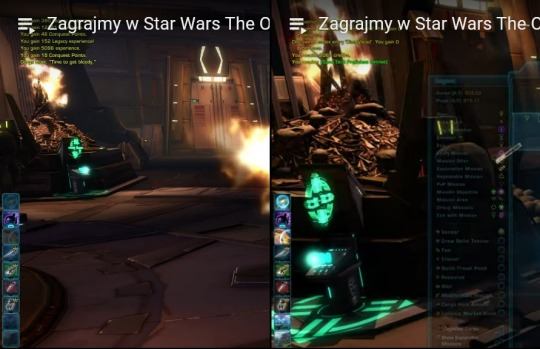
On one of the ships, there was even a great statue that resembles Mandalore the Ultimate
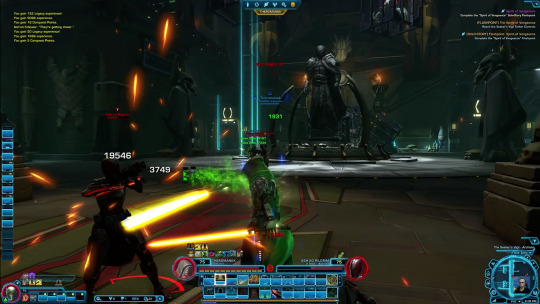
but could actually represent a god (Destructor maybe?), considering all the bones - sacrifices? - piled up around.
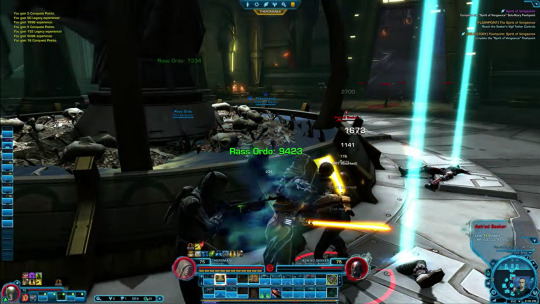
This is one of the better documented examples of likely religious practice among warriors.
In general, The Old Republic game is so far the one major source providing the most direct information about Kad Ha’rangir in relation to the events taking place, while “Death Watch Manifesto” [Bounty Hunter Code] and “Industry. Honor. Savagery: Shaping the Mandalorian Soul” [The Essential Guide to Warfare] were written in distant modern times. At the same time, the game did not include the traditional Mandalorian (Taung) mythosaur axe, as in this era the swords are the most common weapon alongside blasters. Which leads me to believe that Kad Ha’rangir may be a side effect of religious renewal that happened decades after the original Mandalorians died out, as religion in itself is a very good carrier of culture and binder for a broken community. As post-KotOR sources provided, Mandalorian people were divided and in need of symbol(s) under which they could unite - a need recognized by both Shae Vizsla and Kol Heta. Thus the founder of the Ha'rangir clan could become one of such symbols and his achievements and/or charisma at some point grew into a myth affecting Mandalorian people’s perception of original (Taung) gods. As humans dominated warrior society, it makes sense that some aspects of older culture took different shapes to fulfill their needs.
My final conclusion (theory) is that the “Destructor” was part of Taung mythology albeit there was no connection between warrior god and sword/sabers - if anything, the deity’s attribute was an axe which is why the weapon was held in such great regard. However once Taung died out leaving remnants of Mandalorians scattered and broken, some warriors took upon themselves to resurrect their culture. Ordo Canderous tried to unite Mandalorians under his banner (against Sith), while some time later, Kad Ha’rangir, as a historical figure, brought changes - religious reformation? - that influenced perception of old mythology and somehow, maybe in honor of his name, swords for good replaced mythosaur axes. Later, Tarre Vizsla - the first Mandalorian Jedi - created darksaber that became another important relic that affected his people’s spiritual and material culture.
The modern authors based their knowledge in majority on sources that were passed down to their era and could over time become distorted or their original meaning has completely lost. Which could explain the discrepancies between what sources showed and the knowledge of the (in-universe) authors.
SIDENOTES:
[12] Lane said this story about her brother's death:

Years ago, Kur Ha'rangir challenged my brother to a duel. Over some perceived slight against his famous name. Kur used nothing but underhanded tricks-like he does with everything else, There was no honor in the way he fought... He killed by brother... and no one called out Kur's deception. Typical, for a Ha'rangir.
[13] Another example implying Taungs & Neo-Crusaders had a special respect for (dead) ancestors/family members is the specific greeting used by Mandalore the Ultimate during meeting with Arkanian leader

... and all honor to your family's dead [KotOR #20]
And Ko Sornell while adressing Cassus Fett (one of the closest advisors of Mandalore):
Su'cuy, Cassus Fett, and all honor to your family's dead. [KotOR: Interference short story]
[14] The honor duel does not exactly need to end with the loser's death, as Ulic spared Mandalore the Indomitable’s life but as sources show, death was an usual occurrence. Frankly, the example of Canderous Ordo vs Jagi implies that once the challenge was issued there was no way to revoke it. Even though Jagi learned that his former commander’s action were not motivated by selfishness (glory-seeking) as he assumed for years and accepted his accusation turned out to be false and unfair, the man committed suicide to clean his own name:
Canderous: I saw a chance and had to take it. It ended the battle quicker than we would have otherwise, and many of our warriors may have died. Mandalore taught us that opportunism and flexibility in battle were to be admired. You may contradict me, but do you contradict him as well?
Jagi: No! I... I... I see that I have been wrong. I have not been true to the teachings of Mandalore. You were right. I was wrong to question your honor. But I must now cleanse mine with my life.

Jagi didn't haveto fight Canderous, and you tried to persuade him not to. The Mandalorian sense of honor, however, would not let him live having done what he has.
Jagi took his own life in the Dune Sea. This has deeply affected Candeour. [KotOR game]
[15] Similar like clone trooper KADDAK used the name of Mandalorian god in Darth Vader: Cry of the Shadow
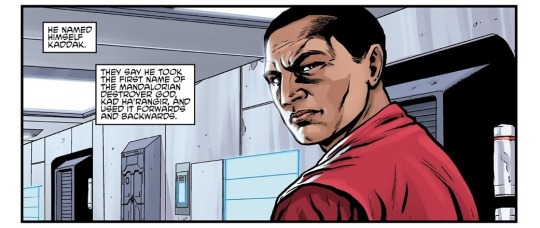
He named himself Kaddak. They say he took the first name of the Mandalorian Destroyer God, Kad Ha'rangir, and used it forwards and backwards.
#star wars#mandalorians#mandalorian culture#Cienie’s take on Mandalorian Culture#kad ha'rangir#taungs#to my regret i couldn't use all screenshots and frames I had collected due to picture limits lol#i finally finished it#i strongly believe that taungs knew the god of destruction but rather under simple name of ha'rangir#while the “kad” part was added over time#and started the era of sword / saber and its special role in mandalorian culture & religion#mandalorian culture is pretty dynamic one when it comes to changes and evolutions or rather revolutions
17 notes
·
View notes
Photo
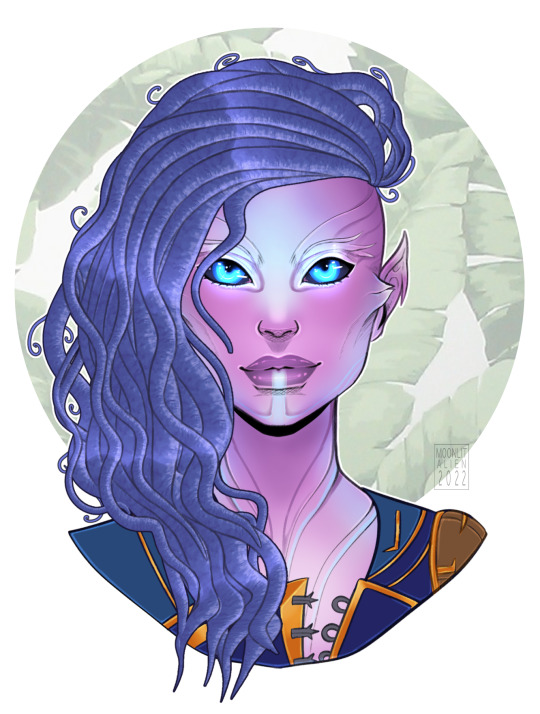


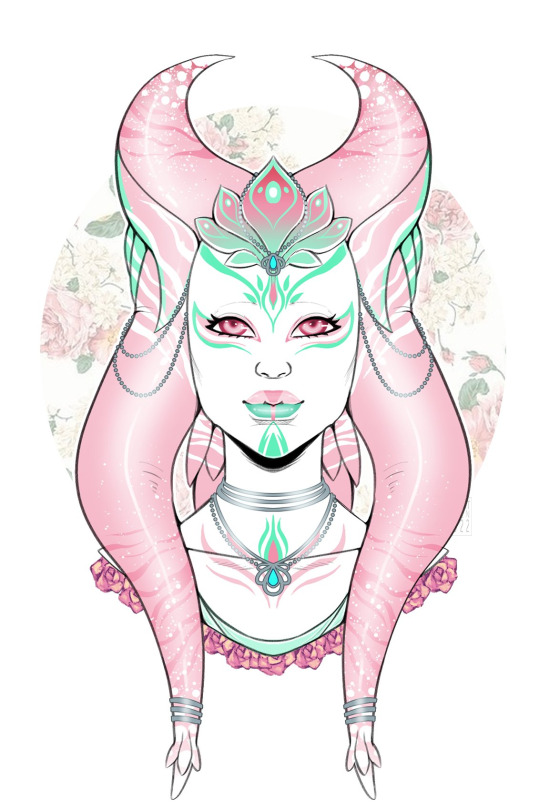
Symmetry portrait commissions for LiegeOfSwords, @jaxsor, @/mutantfishy on Instagram and @/MidnightBlanche on Twitter!!
73 notes
·
View notes
Text
Mandalorian culture master post part 1
(Not Disney era, which is not canon in the eyes of the og fans)
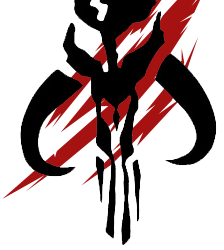
The Beginning of Mandalorian Culture and Lineage
A millennia before the battle of Yavin 4, Mandalorian history began with the Taung. These shadow warriors once lived on the core world, Coruscant, before their enemies drove them from the core into the outer rim, across the galaxy, and far into wild space.
The clans travelled from planet to planet on orders from their war chief, who interpreted the will of their extinct gods. The names of the gods were; Kad Ha’rangir, the all-seeing god of trials and tests; Hod ha’ran, the trickster agent of fickle fortune; and Asasuum the god of sloth, an enemy whispering and seducing promises of peace. During this time, many planets and their people fell to these Mandalorian.
These Mandalorians went everywhere across the galaxy until they found the Mandalor system in the outer rim territories. There had been no sapian lifeform on Mandalor until the Taung came to the planet.
They wanted to prove they won the planet, so they hunted the mythosaur, massive creatures that roamed the planet. Once done, they left the mythosaur bones on the plains as proof, and used the skulls for the clan's symbol.
The Taung then inhabited the planet permanently and began raiding other planets on crusades for their gods.
13 notes
·
View notes
Photo

16 notes
·
View notes